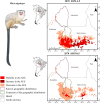New records and modelling the impacts of climate change on the black-tailed marmosets
- PMID: 34492030
- PMCID: PMC8423304
- DOI: 10.1371/journal.pone.0256270
New records and modelling the impacts of climate change on the black-tailed marmosets
Abstract
Climate change represents an unprecedented threat to global biodiversity and, for many species, gaps in our knowledge of their biology remain acute. Gaps in baseline knowledge, such as confirmed identifications (Linnean shortfalls) and adequate collections (Wallacean shortfalls), need to be minimized with new studies, since this is often critical for effective conservation. Despite the increase in scientific research on primates in the southwest of the Brazilian Amazon, little is known about the species Mico nigriceps (Ferrari & Lopes, 1992) Primates, Platirryni. In the current study, we sought to reduce the extent of the Wallacean shortfall for M. nigriceps, understand whether climate change represents a threat to the distribution of the species, and identify priority areas for its conservation. Accordingly, we provide 121 new records in 14 locations, obtained directly from the field, and five from the literature. Using this, we carried out ecological niche modeling, to better understand how environmental suitability might limit the area occupied by the species. We then projected a distribution for 2070 with the SSP2-4.5 (more optimistic) and SSP5-8.5 (more pessimistic) scenarios. Our data confirmed the geographic distribution of the species as being restricted to headwaters of the Ji-Paraná/Machado river, but with a 400 km extension to the south. Under the modeled climate change scenarios, the area suitable for the species declines by 21% under the most optimistic, and by 27% in the pessimistic, scenario across the projected 50-year period. Although we have expanded the area of known occurrence for this species, we point out that climate change threatens the stability of this newly-discovered population strongly, and that this danger is intensified by deforestation, fire and hunting. We recommend that further studies be carried out to confirm the presence of the species in adjacent areas, those indicated by generated models as being potential environmentally suitable. In addition, we recommend intensifying forest restoration in currently pastured areas, and protection of the areas forming the current and future habitat of this species through such measures as protected area creation.
Conflict of interest statement
No authors have competing intests.
Figures



References
-
- IPCC. Climate change: Synthesis report. Team CW, Pachauri R., Reisinger A, editors. Geneva: IPCC; 2007.
-
- Molinos JG, Poloczanska ES, Olden JD, Lawler JJ, Burrows MT. Biogeographical shifts and climate change. Encyclopedia of the Anthropocene. Elsevier Inc.; 2017. doi: 10.1016/B978-0-12-809665-9.09814-1 - DOI
-
- Zwiener VP, Lira-Noriega A, Grady CJ, Padial AA, Vitule JRSS. Climate change as a driver of biotic homogenization of woody plants in the Atlantic Forest. Glob Ecol Biogeogr. 2018;27: 298–309. doi: 10.1111/geb.12695 - DOI
Publication types
MeSH terms
Supplementary concepts
LinkOut - more resources
Full Text Sources
Medical

